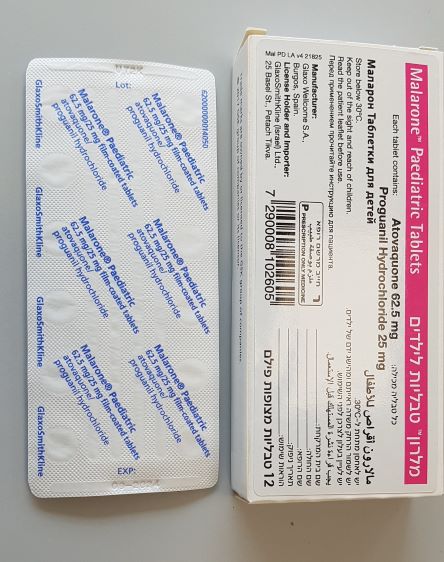Quest for the right Drug

מלרון טבליות לילדים MALARONE PAEDIATRIC TABLETS (ATOVAQUONE, PROGUANIL HYDROCHLORIDE)
תרופה במרשם
תרופה בסל
נרקוטיקה
ציטוטוקסיקה
צורת מתן:
פומי : PER OS
צורת מינון:
טבליות מצופות פילם : FILM COATED TABLETS
עלון לרופא
מינוניםPosology התוויות
Indications תופעות לוואי
Adverse reactions התוויות נגד
Contraindications אינטראקציות
Interactions מינון יתר
Overdose הריון/הנקה
Pregnancy & Lactation אוכלוסיות מיוחדות
Special populations תכונות פרמקולוגיות
Pharmacological properties מידע רוקחי
Pharmaceutical particulars אזהרת שימוש
Special Warning עלון לרופא
Physicians Leaflet
Special Warning : אזהרת שימוש
4.4 Special warnings and precautions for use Persons taking Malarone for prophylaxis or treatment of malaria should take a repeat dose if they vomit within 1 hour of dosing. In the event of diarrhoea, normal dosing should be continued. Absorption of atovaquone may be reduced in patients with diarrhoea or vomiting, but diarrhoea or vomiting was not associated with reduced efficacy in clinical trials of Malarone for malaria prophylaxis. However, as with other antimalarial agents, subjects with diarrhoea or vomiting should be advised to continue with malaria prevention measures by complying with personal protection measures (repellants, bednets). In patients with acute malaria who present with diarrhoea or vomiting, alternative therapy should be considered. If Malarone is used to treat malaria in these patients, parasitaemia and the patient’s clinical condition should be closely monitored. Malarone has not been evaluated for the treatment of cerebral malaria or other severe manifestations of complicated malaria including hyperparasitaemia, pulmonary oedema or renal failure. Occasionally, severe allergic reactions (including anaphylaxis) have been reported in patients taking Malarone. If patients experience an allergic reaction (see section 4.8) Malarone should be discontinued promptly and appropriate treatment initiated. Malarone has been shown to have no efficacy against hypnozoites of Plasmodium vivax as parasite relapse occurred commonly when P. vivax malaria was treated with Malarone alone. Travellers with intense exposure to P. vivax or P. ovale, and those who develop malaria caused by either of these parasites, will require additional treatment with a drug that is active against hypnozoites. In the event of recrudescent infections due to P. falciparum after treatment with Malarone, or failure of chemoprophylaxis with Malarone, patients should be treated with a different blood schizonticide as such events can reflect a resistance of the parasite. Parasitaemia should be closely monitored in patients receiving concurrent tetracycline (see section 4.5). The concomitant administration of Malarone and efavirenz or boosted protease-inhibitors should be avoided whenever possible (see section 4.5). The concomitant administration of Malarone and rifampicin or rifabutin is not recommended (see section 4.5). Concurrent use of metoclopramide is not recommended. Another antiemetic treatment should be given (see section 4.5). Caution is advised when initiating or withdrawing malaria prophylaxis or treatment with Malarone in patients on continuous treatment with warfarin and other coumarin based anticoagulants (see section 4.5). Atovaquone can increase the levels of etoposide and its metabolite (see section 4.5). In patients with severe renal impairment (creatinine clearance <30 mL/min) alternatives to Malarone for treatment of acute P. falciparum malaria should be recommended whenever possible (see sections 4.2, 4.3 and 5.2). Malarone Tablets for adults The safety and effectiveness of Malarone tablets for adults (atovaquone 250mg/proguanil hydrochloride 100mg tablets) has not been established for prophylaxis of malaria in patients who weigh less than 40kg, or in the treatment of malaria in paediatric patients who weigh less than 11kg. Malarone Paediatric Tablets The safety and effectiveness of Malarone paediatric tablets for the prophylaxis of malaria in children who weigh less than 11 kg and the treatment of malaria in children who weigh less than 5 kg have not been established. Malarone paediatric tablets are not indicated for the treatment of acute uncomplicated P. falciparum malaria in individuals weighing 11-40 kg. Malarone tablets for adults (atovaquone 250mg/proguanil hydrochloride 100mg tablets) should be used in these individuals (see section 4.2). This medicine contains less than 1 mmol sodium (23 mg) per tablet, that is to say essentially ‘sodium free’.
Effects on Driving
4.7 Effects on ability to drive and use machines Dizziness has been reported. Patients should be warned that if affected they should not drive, operate machinery or take part in activities where this may put themselves or others at risk.

שימוש לפי פנקס קופ''ח כללית 1994
לא צוין
תאריך הכללה מקורי בסל
לא צוין
הגבלות
לא צוין
מידע נוסף
